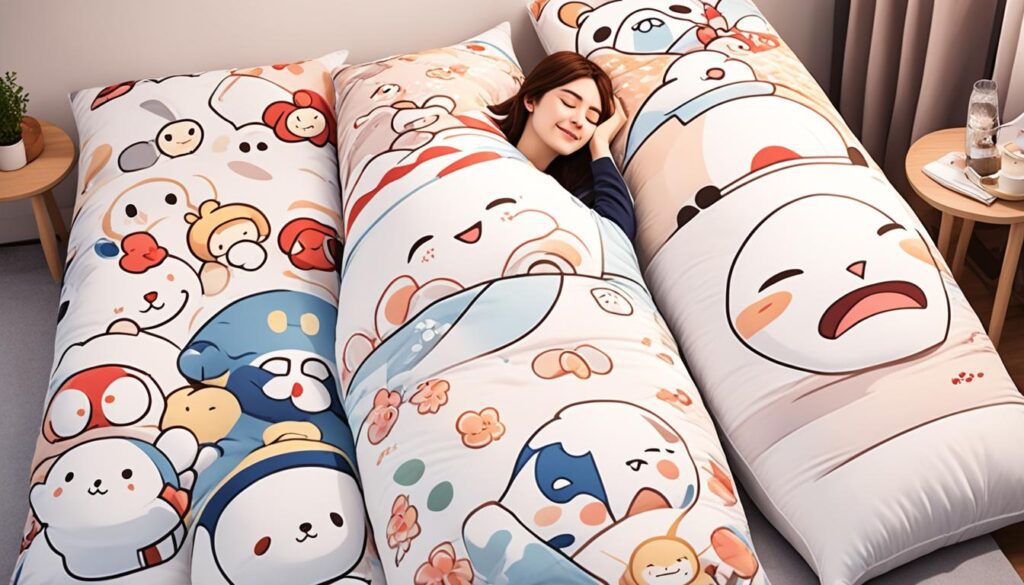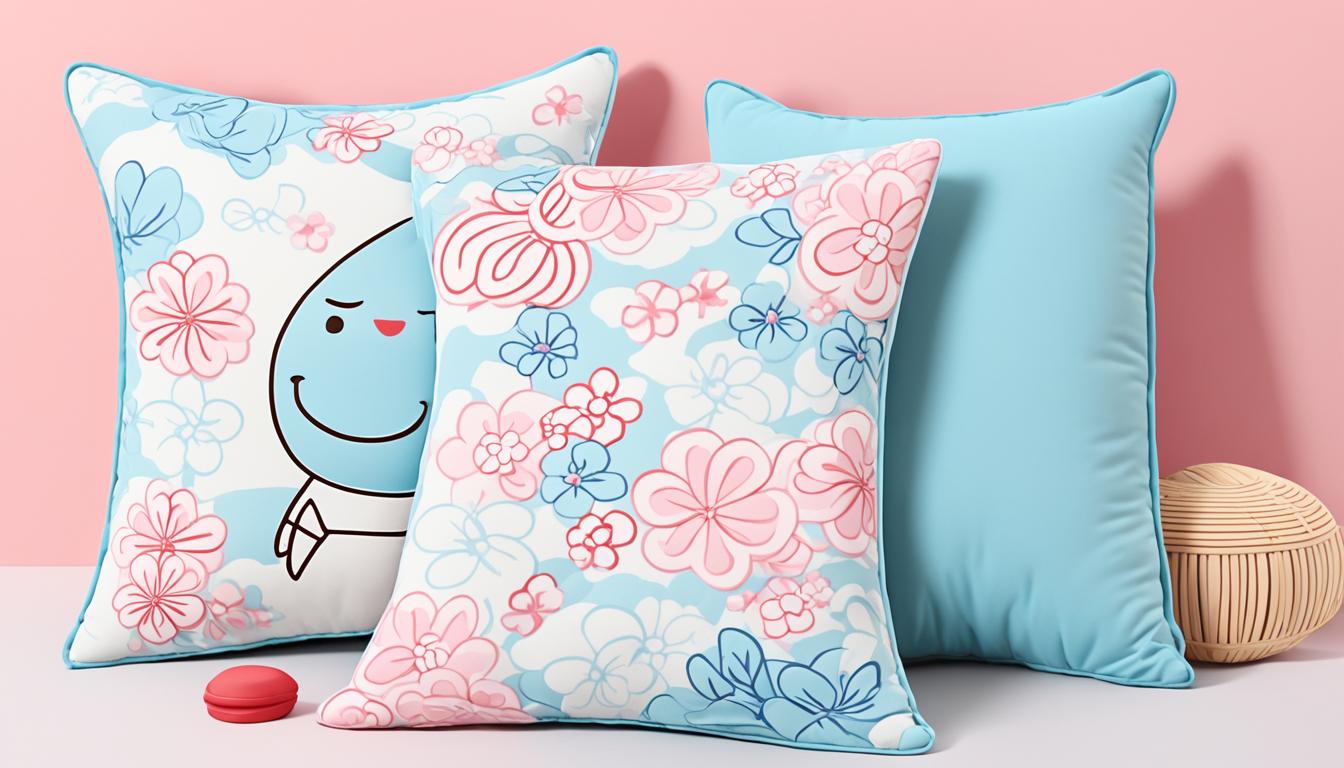Welcome to our guide on how to say “body pillow” in Japanese! If you’re interested in Japanese language and culture or simply want to add some linguistic flair to your vocabulary, this article is for you.
In Japanese, the term for body pillow is “dakimakura” (抱き枕), which translates to “hug pillow” in English. The word dakimakura is a combination of “daki” (抱き) meaning “to embrace” and “makura” (枕) meaning “pillow.”
To pronounce “dakimakura” in Japanese, break it down into syllables: “da-ki-ma-ku-ra”.
Here is the kanji representation of dakimakura: 抱き枕.
Dakimakura is a widely recognized term in Japan and is commonly used by Japanese youth as comfort objects. They are often coupled with pillow covers featuring popular anime characters.
So, next time you want to express “body pillow” in Japanese, remember the term “dakimakura”! Don’t forget to check out our other sections to learn more about the history, sizes, and cultural significance of dakimakura.
The History of Dakimakura
The history of dakimakura dates back to the late ’90s and early 2000s, when they became closely intertwined with otaku culture in Japan. Otaku culture refers to a subculture of dedicated anime and manga fans.
During this time, dakimakura pillow covers featuring printed images of bishōjo and bishōnen characters from various anime or bishōjo games gained popularity. These pillow covers were released through Cospa, a character goods and apparel store known for its association with otaku culture.
In 2015, the evolution of dakimakura took a new turn with the introduction of talking body pillows by Ita-Supo and its mascot, Rina Makuraba. The inventor of these innovative pillows was Koichi Uchimura, a former researcher from the Kyushu Institute of Technology.
| Year | Milestone |
|---|---|
| Late ’90s – Early 2000s | Dakimakura pillow covers featuring bishōjo and bishōnen characters gain popularity in otaku culture |
| 2015 | Introduction of the first talking body pillows by Ita-Supo and Rina Makuraba |
| Invention of talking body pillows by Koichi Uchimura |
Sizes of Dakimakura
Dakimakura, the beloved body pillows originating from Japan, come in various sizes to accommodate different preferences and needs. The standard dakimakura sizes include 160 cm (63 in) and 150 cm (59 in) in length, with a width of 50 cm (20 in). However, the popularity of the 150 cm dakimakura has been on the rise in recent years due to cost-saving measures. Let’s explore the different sizes and their significance in the world of dakimakura.
Before the mid-2000s, dakimakura were primarily available in the 160 cm size. However, to reduce shipping costs, manufacturers introduced the 150 cm dakimakura, which quickly gained popularity. By reducing the weight of the pillow to stay under the 2 kg airmail weight limit, shipping became more affordable for enthusiasts around the world.
As the demand for dakimakura grew, manufacturers started introducing new sizes to cater to diverse preferences. While there are several other sizes available, let’s take a look at the five most popular ones:
| Dakimakura Size | Dimensions |
|---|---|
| 180×60 cm | Extra Large |
| 170×60 cm | Large |
| 160×60 cm | Standard |
| 150×50 cm | Popular |
| 140×40 cm | Compact |
These sizes offer options for dakimakura enthusiasts of different heights and ages, ensuring that everyone can find a comfortable size to embrace their favorite characters.
Incorporating dakimakura into your collection allows you to express your passion for anime and manga while enjoying the comfort and companionship they provide. Stay tuned as we delve deeper into the fascinating world of dakimakura and its connection to otaku culture.
Love Pillows
Love pillows are a popular subset of dakimakura that caters to specific fetishes and fantasies. These pillows feature life-size pictures of characters in suggestive poses, which can include anime characters, furry characters, or even pornographic film actors. The portrayal of characters in suggestive poses on love pillows brings the fantasies of fans to life, allowing them to form a deeper connection with their favorite characters. It’s important to note that not all dakimakura pillowcases have explicit or adult content. There are plenty of family-friendly designs available that feature popular anime characters or other non-explicit artwork.
While love pillows are often associated with adult content, it’s crucial to acknowledge that dakimakura as a whole encompasses a wide range of designs. These designs cater to the diverse preferences of fans and collectors. Love pillows serve as a form of self-expression and allow fans to indulge in their passions while respecting the boundaries of their comfort levels. Whether it’s a cute and innocent anime character or a bold and provocative furry character, love pillows provide fans with the opportunity to surround themselves with artwork that resonates with them on a personal level.
The Connection Between Dakimakura and Otaku Culture
Dakimakura are deeply connected to otaku culture in Japan. Otaku refers to individuals who are passionate fans of anime, manga, and other aspects of Japanese pop culture. As a part of otaku culture, dakimakura hold a special place in the hearts of fans, serving as both collectible items and comfort objects.
Dakimakura are often seen as symbols of fandom and devotion to specific anime or manga series. Fans take pride in owning dakimakura featuring their favorite characters, as it showcases their love and dedication to the series or franchise.
Aside from being collectible items, dakimakura also serve as comfort objects within otaku culture. Fans find emotional support and a sense of comfort from hugging and embracing their dakimakura, providing a feeling of closeness to their favorite characters.
| Dakimakura as a Part of Otaku Culture | ||
|---|---|---|
| Anime and Manga Fandom | Dakimakura are embraced by fans as a way to express their passion for anime and manga. | |
| Dakimakura as a Symbol of Fandom | Owning a dakimakura featuring a beloved character showcases dedication and love for a specific series or franchise. | |
| Dakimakura as a Comfort Object | Hugging and embracing a dakimakura provides emotional support and a sense of comfort to fans. |
Dakimakura as a Cultural Phenomenon in Japan
Dakimakura, also known as body pillows, have become a cultural phenomenon in Japan. They have gained widespread popularity and acceptance, extending beyond just anime and manga fans. Dakimakura have found their way into mainstream culture and have become an iconic symbol of Japanese pop culture.
In Japan, dakimakura are not only used for comfort but have also become official merchandise for popular anime and manga series. Many anime and manga creators recognize the appeal of dakimakura and release official pillow covers featuring their characters. These merchandise items allow fans to express their love for a specific series and feel closer to their favorite characters.
Additionally, dakimakura have become a sought-after souvenir item in Japan. Tourists often purchase dakimakura featuring popular anime characters as a unique and memorable keepsake from their trip. These pillows serve as a reminder of their time in Japan and their enjoyment of the country’s vibrant pop culture.
The widespread popularity of dakimakura reflects the deep appreciation for anime and manga in Japanese society. They have become a cultural touchstone, representing the passion and dedication of fans. The connection between dakimakura and Japanese culture demonstrates the significant impact of these comfort objects on the nation’s identity and collective imagination.
Dakimakura as Comfort Objects and Emotional Support

Dakimakura serve as more than just decorative pillows; they are also comfort objects that provide emotional support to individuals. Similar to a security blanket or a favorite stuffed toy, dakimakura offer a sense of comfort and security.
One of the main ways dakimakura provide emotional support is by alleviating feelings of loneliness and providing a feeling of companionship. The act of hugging or embracing a dakimakura can create a sense of closeness and connection, especially for individuals who may be going through difficult times or seeking solace.
The presence of a dakimakura can bring comfort and a sense of familiarity. When you hug a dakimakura featuring your favorite character, it can provide a source of comfort, bringing a feeling of warmth and security. This can be particularly beneficial during times of stress, anxiety, or when seeking solace.
For those who live alone or are physically distanced from loved ones, a dakimakura can provide a form of companionship. The familiar image of a beloved character can offer emotional support and create a sense of well-being.
Dakimakura truly embody the idea of finding comfort in the embrace of your favorite character, offering a sense of comfort and emotional security. Whether you seek companionship, solace, or simply a comforting presence, a dakimakura can be a source of comfort in your life.
Health Benefits of Dakimakura
Dakimakura offer several health benefits to users. They provide support during sleep, helping to align the body and maintain correct posture. This can alleviate muscle pain and promote better spinal alignment.
In addition, dakimakura can be beneficial for individuals who snore or have blood circulation problems. The support provided by a dakimakura can help improve sleep quality and reduce discomfort, allowing for a more restful night’s sleep.
Moreover, the emotional support and comfort provided by a dakimakura can contribute to overall well-being and mental health. By providing a sense of security and familiarity, a dakimakura can help reduce stress and promote relaxation, allowing you to unwind and sleep peacefully.
So, if you’re looking for a cozy and supportive companion that can improve your sleep posture, alleviate muscle pain, address snoring issues, and enhance blood circulation, a dakimakura can be a beneficial addition to your sleep routine.

